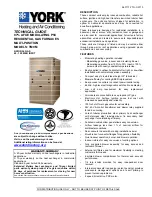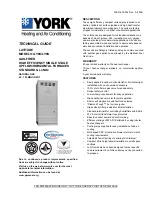
035-17468-001 Rev. A (801)
28
Unitary Products Group
Once the correct gas pressure to the burners has been
established, turn the gas valve switch to OFF and turn the
electrical supply switch to OFF; then remove the pressure tap
at the gas valve and re-install the plug, using a compound (on
the threads) resistant to the action of LP gases. Replace the
burner box front cover or the pressure reference hose.
Turn the electrical and gas supplies back on, and with the
burners in operation, check for gas leakage around the plug
with a soap and water solution.
ADJUSTMENT OF TEMPERATURE RISE
DIRECT DRIVE MOTORS
(ONLY APPLIES TO PSC
REPLACEMENT)
The temperature rise, or temperature difference between the
return air and the heated air from the furnace, must be within
the range shown on the furnace rating plate. Application limi-
tations are shown in Table 1 or 2. After the temperature rise
has been determined, the cfm can be calculated.
After about 20 minutes of operation, determine the furnace
temperature rise. Take readings of both the return air and the
heated air in the ducts, about six feet from the furnace where
they will not be affected by radiant heat.
Increase the blower speed to decrease the temperature rise;
decrease the blower speed to increase the rise.
All direct-drive blowers have multi-speed motors. The blower
motor speed taps are located in the control box in the blower
compartment.
You may select a heating speed and a cooling speed. They
may be the same speed or a different speed.
To use the same speed tap for heating and cooling, the heat
terminal and cool terminal must be connected using a jumper
wire and connected to the desired motor lead. Place all
unused motor leads on Park terminals. Two Park terminals
are provided.
VARIABLE SPEED MOTORS
The temperature rise, or temperature difference between the
return air and the heated air from the furnace, must be within
the range shown on the furnace rating plate and within the
application limitations shown in Table 1 on Page 5 or Table 2
on Page 6.
WITH BURNER BOX COVER IN PLACE
WITH BURNER BOX COVER REMOVED
FIGURE 38 :
Reading Gas Pressure - Downflow/Horizontal Models
GAS VALVE
OUTLET
PRESSURE
TAP
BURNER BOX
PRESSURE
REFERENCE HOSE
BURNER BOX
WITH COVER
U-TUBE
MANOMETER
3.5 IN
WATER COLUMN
GAS PRESSURE
SHOWN
TEE
FITTING
6
5
4
3
2
1
0
1
2
3
4
5
6
GAS VALVE
OUTLET
PRESSURE
TAP
BURNER BOX
PRESSURE
REFERENCE
HOSE
BURNER BOX WITH
COVER REMOVED
U-TUBE
MANOMETER
3.5 IN
WATER COLUMN
GAS PRESSURE
SHOWN
6
5
4
3
2
1
0
1
2
3
4
5
6
The manifold pressure must be checked with the
screw-off cap for the gas valve pressure regulator in
place. If not, the nominal manifold pressure setting
will result in an over-fire condition.
If manifold pressure is too high, an over-fire condi-
tion exists which could cause heat exchanger fail-
ure. If the manifold pressure is too low, sooting and
eventual clogging of the heat exchanger could
occur.
Be sure that gas valve regulator cap is replaced and
burner box to gas valve pressure reference hose is
reconnected.
Do not energize more than one motor speed at a
time or damage to the motor will result.













































